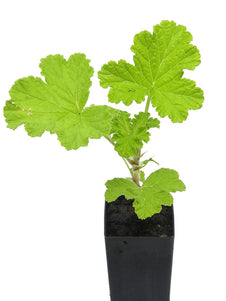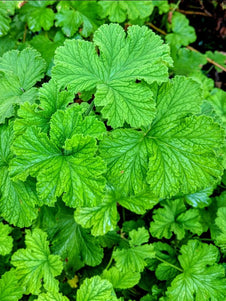





Scented Geranium Lemon Verbena
Scented Geranium Lemon Verbena

- In stock, ready to ship
- Inventory on the way

Usually available: April to November
Life cycle: Perennial
Height: 1.2m
Position: Sun / part shade
Soil preference: Well drained
This is how we pack and send your Herb Plants to all states except TAS & WA
You will receive
- 1 Lemon Verbena Scented Geranium Herb Plant in a 50 X 75mm tube - General growing instructions
All of our Herb Plants are grown organically with certified organic potting mixes and fertilizers
Botanical Name:
Pelargonium General Notes
Pelargoniums are evergreen perennials, sharing many common characteristics with the Geranium species. They range in height from 30- 100cm and may be categorized based on varying leaf shapes, such as crinkled, oak or fern leaf shapes. The leaf colour may vary from deep to light green, with flowers generally held in loose clusters. Most prefer to grow in full sun and they are also drought and heat tolerant. However, some varieties do require some shade and moist conditions where possible. Many grow near streams in their native habitats, but generally ‘less is more’ is a good guideline for watering these plants. They do not like to be damp at all.
This group of plants were initially catalogued by Linnaeus into the same Genus as Geraniums, but were separated into separate genera in 1789. Pelargoniums were taken to England in 1631, but it is likely they were transported to Holland in the earlier 1600’s. Since early times various varieties have been developed and many are now cultivated commercially for the essential oils used in perfumery and aromatherapy.
The Pelargonium genus is one of five in the family Geraniaceae, which has over 800 species. This includes the separate Geranium genus, which often causes confusion since ‘geranium’ is also used as a common name for the many Pelargonium species and cultivars. There is thought to be 270 species of Pelargonium, with 219 being native to South Africa. Among these, there is a number of genera or subtypes of pelargonium based on features such as leaf type. Of this selection about 80% are native only to select areas in the southern regions of South Africa. The remaining 20% are found in Australia, New Zealand and a few select areas such as Madagascar and Eastern Africa. There are now cultivated varieties all over the world, most with origins in South Africa. The true Geranium species is a hardy group of plants native to North America and Europe.
The Geranium plant family is an important food source for certain Lepidoptera species in their native regions. For more information on our other Scented Geranium listings.
Growing Conditions
Most pelargoniums enjoy full sun. Pelargonium graveolens grows very well in semi-shaded positions and is good as a filler plant in larger gardens. It requires a moist, but not damp environment, with well- drained soil.
This plant also grows well in containers and hanging baskets. In cold regions it may even be taken indoors, but may be better treated as an annual if this is not possible. Although, not very tolerant of frost some plants may die down and return when the weather warms in spring. It may be propagated by tip or stem cuttings taken in autumn or spring.
Culinary Uses
Pelargoniums are usually suitable for culinary use, particularly the leaves and flowers. They may be used for herbal teas and to sweeten and scent desserts such as cakes and jelly. The most commonly used are those with rose, lemon and peppermint scents. Leaves may be cut and placed in ice cube trays for later use in iced tea or other suitable cold drinks.
A tea infusion may be made using 3 teaspoons of freshly chopped leaves, or 1 teaspoon of dried leaves, and 1 cup (250mls) of boiling water. Let the leaves steep, strain and then drink as needed. There are several varieties suitable for a tea infusion, but it may be a matter of taste. This particular scented geranium offers a flavour similar to lemon verbena tea.
All information provided on this website is for informational purposes only. Please seek professional advice before commencing any treatment.





